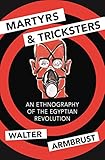Martyrs and Tricksters : An Ethnography of the Egyptian Revolution / Walter Armbrust.
Material type: TextSeries: Princeton Studies in Muslim Politics ; 72Publisher: Princeton, NJ : Princeton University Press, [2019]Copyright date: ©2019Description: 1 online resource (344 p.) : 36 b/w illusContent type:
TextSeries: Princeton Studies in Muslim Politics ; 72Publisher: Princeton, NJ : Princeton University Press, [2019]Copyright date: ©2019Description: 1 online resource (344 p.) : 36 b/w illusContent type: - 9780691162645
- 9780691197517
- 962.056 23
- DT107.88
- online - DeGruyter
- Issued also in print.
| Item type | Current library | Call number | URL | Status | Notes | Barcode | |
|---|---|---|---|---|---|---|---|
 eBook
eBook
|
Biblioteca "Angelicum" Pont. Univ. S.Tommaso d'Aquino Nuvola online | online - DeGruyter (Browse shelf(Opens below)) | Online access | Not for loan (Accesso limitato) | Accesso per gli utenti autorizzati / Access for authorized users | (dgr)9780691197517 |
Frontmatter -- Contents -- Illustrations -- Acknowledgments -- Note on Transliteration -- Time Line -- The "Last Day of the Revolution"? -- Chapter 1. Introduction Revolution as Liminal Crisis -- Prelude My Eighteen Days -- Chapter 2. The Material Frame -- Chapter 3. The Martyrological Frame -- Chapter 4. The Disputed Grievability of Sally Zahran -- Chapter 5. Martyr Milestones -- Chapter 6. The Poor First -- Chapter 7. Copts and Salafis Dueling YouTube Videos on the Edge of a Precipice -- Chapter 8. Scripting a Massacre -- Chapter 9. The Trickster in Midan al-' Abbasiyya -- Chapter 10. A New Normal? The Iron Fist and the False Promise -- Postscript. Zizo's Suicide Letter -- Notes -- References -- Index
restricted access online access with authorization star
http://purl.org/coar/access_right/c_16ec
An important look at the hopeful rise and tragic defeat of the Egyptian Revolution of 2011The Egyptian Revolution of 2011 began with immense hope, but was defeated in two and a half years, ushering in the most brutal and corrupt regime in modern Egyptian history. How was the passage from utmost euphoria into abject despair experienced, not only by those committed to revolutionary change, but also by people indifferent or even hostile to the revolution? In Martyrs and Tricksters, anthropologist and Cairo resident Walter Armbrust explores the revolution through the lens of liminality-initially a communal fellowship, where everything seemed possible, transformed into a devastating limbo with no exit. To make sense of events, Armbrust looks at the martyrs, trickster media personalities, public spaces, contested narratives, historical allusions, and factional struggles during this chaotic time.Armbrust shows that while martyrs became the primary symbols of mobilization, no one took seriously enough the emergence of political tricksters. Tricksters appeared in media-not the vaunted social media of a "Facebook revolution" but television-and they paved the way for the rise of Abd al-Fattah al-Sisi. In the end Egypt became a global political vanguard, but not in the way the revolutionaries intended. What initially appeared as the gateway to an age of revolution has transformed the world over into the age of the trickster.Delving into how Egyptians moved from unprecedented exhilaration to confusion and massacre, Martyrs and Tricksters is a powerful cultural biography of a tragic revolution.
Issued also in print.
Mode of access: Internet via World Wide Web.
In English.
Description based on online resource; title from PDF title page (publisher's Web site, viewed 21. Jun 2021)


